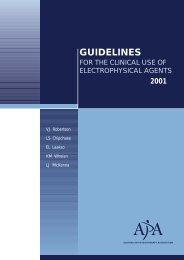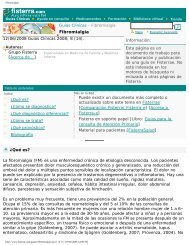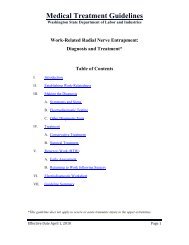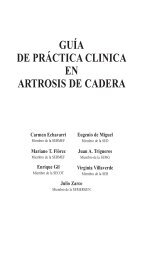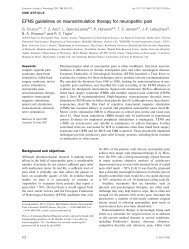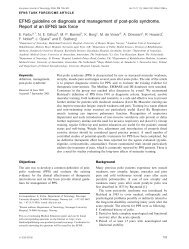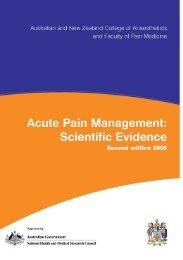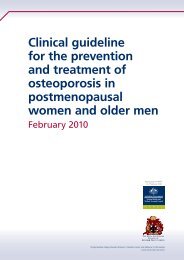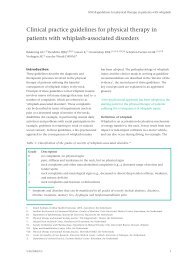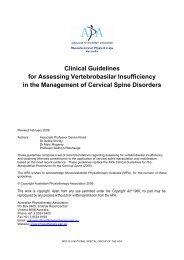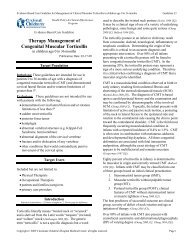Practice Parameter and Literature Review of the Usefulness of ...
Practice Parameter and Literature Review of the Usefulness of ...
Practice Parameter and Literature Review of the Usefulness of ...
Create successful ePaper yourself
Turn your PDF publications into a flip-book with our unique Google optimized e-Paper software.
<strong>Practice</strong> <strong>Parameter</strong>: Carpal Tunnel Syndromeclinical findings <strong>of</strong> <strong>the</strong>nar muscle weakness <strong>and</strong> atrophy.Thus, selection <strong>of</strong> more advanced cases would increase <strong>the</strong>yield <strong>of</strong> EDX abnormalities. A report by Buchthal <strong>and</strong>colleagues 31 in 1974 illustrated this point because <strong>the</strong>yreported a 91% incidence <strong>of</strong> abnormal findings on <strong>the</strong>needle EMG examination <strong>of</strong> <strong>the</strong> abductor pollicis brevis(APB) muscle in CTS patients. Subsequent studies <strong>of</strong> needleEMG findings in CTS 243 <strong>and</strong> <strong>the</strong> consensus <strong>of</strong> members <strong>of</strong><strong>the</strong> 1991 to 1993 AAEM QA Committee <strong>and</strong> <strong>the</strong> AAEMCTS Task Force was that <strong>the</strong> incidence <strong>of</strong> abnormal needleEMG findings in <strong>the</strong> <strong>the</strong>nar muscles <strong>of</strong> CTS patients ismuch less than were reported by Buchthal <strong>and</strong> colleagues 31whose studies were conducted at a national clinical researchcenter.To balance <strong>the</strong> authority <strong>of</strong> a publication meeting <strong>the</strong> 6AAEM CTS LIC in a controlled academic setting with <strong>the</strong>reality <strong>of</strong> clinical experience, <strong>the</strong> 1991 to 1993 QACommittee decided to report data in tables only if <strong>the</strong>maximum incidence <strong>of</strong> any EDX abnormality in all <strong>the</strong> CTSpatients in <strong>the</strong> study was less than 90%. If over 90% <strong>of</strong> <strong>the</strong>patients with a clinical diagnosis <strong>of</strong> CTS demonstrate a testabnormality, <strong>the</strong> results suggest that <strong>the</strong> patient populationwas heavily screened <strong>and</strong>, <strong>the</strong>refore, biased with patientswith advanced CTS. For this reason, <strong>the</strong> studies <strong>of</strong> Casey<strong>and</strong> LeQuesne 39 <strong>and</strong> Cioni <strong>and</strong> colleagues, 47 which met <strong>the</strong> 6literature classification criteria, were not included in <strong>the</strong>table data <strong>of</strong> <strong>the</strong> 1993 publication. This convention waseliminated from <strong>the</strong> current review. Data from all studiesthat met 6 AAEM CTS LIC are displayed in tablesregardless <strong>of</strong> how high or low <strong>the</strong> sensitivity <strong>and</strong> specificity<strong>of</strong> <strong>the</strong> test results so readers can draw <strong>the</strong>ir own conclusions.The AAEM CTS Task Force identified 2 possible sources<strong>of</strong> investigator bias in <strong>the</strong> CTS literature: selection bias <strong>and</strong>observer bias.Selection bias might increase <strong>the</strong> incidence <strong>of</strong> EDX testabnormalities due to inclusion <strong>of</strong> CTS patients with moresevere CTS than usually encountered in a clinical practice.To address prospectively <strong>the</strong> issue <strong>of</strong> selection bias in CTSresearch studies as described above, <strong>the</strong> AAEM CTS TaskForce developed a set <strong>of</strong> criteria for <strong>the</strong> clinical diagnosis <strong>of</strong>CTS to provide a more uniform population <strong>of</strong> CTS patientsfor use in future research studies <strong>of</strong> <strong>the</strong> usefulness <strong>of</strong> EDXstudies to diagnose CTS (see Table 2).Observer bias might increase <strong>the</strong> incidence <strong>of</strong> EDX testabnormalities due to <strong>the</strong> desire <strong>of</strong> <strong>the</strong> researcher todocument <strong>the</strong> usefulness <strong>of</strong> <strong>the</strong> EDX test. To addressprospectively <strong>the</strong> issue <strong>of</strong> observer bias, Sackett <strong>and</strong>colleagues 217 have recommended that clinical researchstudies <strong>of</strong> diagnostic tests be performed with <strong>the</strong> physicianperforming <strong>and</strong> interpreting <strong>the</strong> diagnostic tests blinded to<strong>the</strong> diagnosis <strong>of</strong> <strong>the</strong> subject. At <strong>the</strong> recommendation <strong>of</strong> <strong>the</strong>AAN, <strong>the</strong> AAEM recently endorsed that principle <strong>and</strong>recommends that physicians performing <strong>and</strong> interpreting <strong>the</strong>EDX test as part <strong>of</strong> a clinical research study be blinded to<strong>the</strong> clinical classification <strong>of</strong> <strong>the</strong> research subjects (normal,CTS, disease control).REVIEW OF EDX STUDIESThe identification <strong>of</strong> <strong>the</strong> clinical manifestations <strong>and</strong>operative treatment for symptoms due to compression <strong>of</strong> <strong>the</strong>median nerve in <strong>the</strong> carpal tunnel are generally credited toPhalen 198 although <strong>the</strong>re were earlier reports <strong>of</strong> successfulsurgical treatment <strong>of</strong> median nerve compression in <strong>the</strong>carpal tunnel. 23,37,270,273 In 1953, Kremer published <strong>the</strong>salient clinical feature <strong>of</strong> CTS. 138In 1949, Dawson <strong>and</strong> Scott 54 reported <strong>the</strong> reproduciblerecording <strong>of</strong> nerve action potentials with surface electrodesin arms <strong>of</strong> healthy human subjects after electric stimulation<strong>of</strong> <strong>the</strong> nerves <strong>and</strong> suggested that <strong>the</strong> technique may be usefulin detecting nerve damage. In 1956, Simpson 238 reported <strong>the</strong>observation that <strong>the</strong> median motor distal latency wasprolonged across <strong>the</strong> carpal tunnel in CTS <strong>and</strong> this wasconfirmed by o<strong>the</strong>r investigators: Thomas 252 in 1960 <strong>and</strong>Lambert 141 in 1962. In 1956, Dawson 53 described atechnique for measuring median sensory nerve conductionacross <strong>the</strong> carpal tunnel. In 1958, Gilliatt <strong>and</strong> Sears 85demonstrated slow median sensory nerve conduction across<strong>the</strong> carpal tunnel in patients with CTS. Casey <strong>and</strong>LeQuesne 39 confirmed <strong>the</strong> finding <strong>of</strong> Buchthal <strong>and</strong>Rosenfalck 30 that <strong>the</strong> median nerve conductionabnormalities in CTS were focal <strong>and</strong> localized to <strong>the</strong>segment <strong>of</strong> <strong>the</strong> median nerve in <strong>the</strong> carpal tunnel. Brown 28confirmed <strong>the</strong> localization <strong>of</strong> <strong>the</strong> median nerve conductionabnormalities in CTS patients to be under <strong>the</strong> carpalligament with intraoperative NCSs. O<strong>the</strong>r studies haveverified <strong>the</strong>se reports <strong>and</strong> median sensory <strong>and</strong> motor NCSshave become <strong>the</strong> mainstay for <strong>the</strong> laboratory evaluation <strong>of</strong>CTS. 243Over <strong>the</strong> past 40 years, clinical research efforts have refined<strong>the</strong> techniques <strong>of</strong> median sensory <strong>and</strong> motor NCSs across<strong>the</strong> carpal tunnel to make <strong>the</strong> tests more sensitive <strong>and</strong>specific for <strong>the</strong> detection <strong>of</strong> compression <strong>of</strong> <strong>the</strong> mediannerve in <strong>the</strong> carpal tunnel. 110,181 To make <strong>the</strong> NCSs moresensitive, investigators have developed techniques toexclude <strong>the</strong> normal segment <strong>of</strong> <strong>the</strong> median nerve distal to<strong>the</strong> flexor retinaculum <strong>of</strong> <strong>the</strong> carpal tunnel, 30,52,59,65,104,143,265compared <strong>the</strong> speed <strong>of</strong> median nerve conduction to <strong>the</strong>speed <strong>of</strong> ulnar or radial nerve conduction from <strong>the</strong> sameh<strong>and</strong>, 31,200,216,220,233,253 performed sequential short segment (1cm) sensory <strong>and</strong> motor NCSs, 106,132,224 ,226 <strong>and</strong> compared <strong>the</strong>median nerve conduction across <strong>the</strong> carpal tunnel to mediannerve conduction in <strong>the</strong> forearm or digit. 131,188,189,236,237S928 CTS <strong>Literature</strong> <strong>Review</strong>© 2002 American Association <strong>of</strong> Electrodiagnostic Medicine



